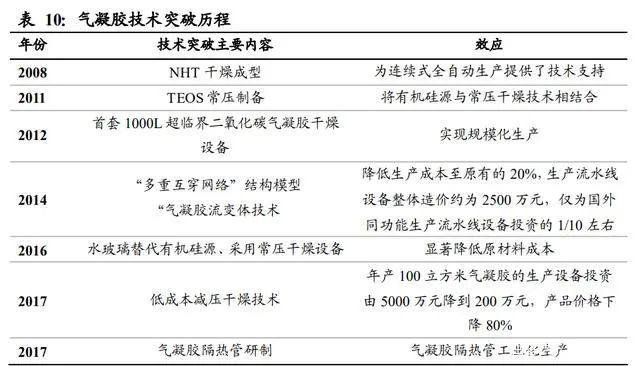Normal pressure process has gradually become the mainstream choice. The cost of aerogel preparation accounts for about 60% of the total cost of the industry chain. According to data from NASA, the average manufacturing cost of each pound of aerogel is as high as US$23,000. Among them, the drying process is the main factor restricting the cost of the preparation process.
Common drying processes in the world are divided into normal pressure drying process and supercritical drying process. The core equipment used in the supercritical drying process is an autoclave, and the general working pressure is as high as 7~20MPa. It is a pressure vessel among special equipment. The equipment system is relatively complex, and the operation and maintenance costs are also high. The fixed asset investment for expanding the production scale is huge. If aerogel meets the huge market of building insulation in the future, it will need to reach an annual output of more than 500,000 cubic meters. The equipment investment of supercritical drying technology will be as high as billions, which is very unfavorable for the scale expansion of aerogel enterprises. As the scale of normal pressure drying technology expands, the input-output ratio will be further improved, and a larger production scale can be achieved with less investment, so it can better meet the needs of large-scale production in the future. In addition, due to the limitation of silicon source, the cost reduction space of supercritical raw materials is limited, and production efficiency can only be improved by optimizing the system. Atmospheric pressure drying has a strong acceptance capacity for cheap silicon sources and a high degree of freedom in process optimization, so it has greater room for cost reduction.
Since the commercialization of aerogel materials in my country in 2004, the optimization of aerogel preparation process has made continuous breakthroughs. The preparation cost has dropped significantly. Aerogel materials have gone out of the laboratory and achieved large-scale production from an annual output of thousands of cubic meters to tens of thousands of cubic meters. The preparation process has also been gradually updated. The original high-cost and long-cycle organic silicon source supercritical preparation process has been replaced by a low-cost inorganic silicon source and an optimized atmospheric pressure preparation process. The quality of the aerogel produced has reached the technical indicators of the supercritical drying process, and the investment return period has been greatly shortened. It has fundamentally gotten rid of the various disadvantages caused by supercritical drying, and the manufacturing cost has been reduced to 1/20 of the supercritical process. We expect that the future development direction of aerogel preparation will still be the selection of silicon sources and process combination optimization of atmospheric pressure drying technology, and the preparation cost will be further reduced to the same level as the preparation of traditional thermal insulation materials. Although it is difficult to reduce the preparation cost of supercritical technology, it is irreplaceable in special fields such as military industry and aerospace due to its extremely high product purity, and will coexist in the market in the future.

Sufficient supply of silicon tetrachloride supports the development of atmospheric pressure process
As an inorganic silicon source, silicon tetrachloride has both cost advantages and breakthroughs in impurity removal technology, which creates conditions for recycling. Most of silicon tetrachloride is a byproduct of polysilicon. Since 2015, domestic enterprises in my country have broken through foreign technical barriers, and purification technology has been continuously breaking through. They have achieved good performance in the removal of metal ion impurities, and have achieved industrial production of electronic grade silicon tetrachloride. By preparing aerogels from byproduct silicon tetrachloride, the polysilicon industry and the aerogel industry can be combined to form an industrial chain, turning waste into treasure. According to statistics, 10 to 15 kilograms of silicon tetrachloride will be produced for every kilogram of polysilicon produced. With the rapid development of the downstream photovoltaic industry of polysilicon, China's annual polysilicon production increased from 165,000 tons to 342,000 tons from 2015 to 2019, with a compound growth rate of 20%. It is estimated that by 2025, my country's annual polysilicon output will reach 1.022 million tons, and the by-product silicon tetrachloride will reach 10.22 million to 15.33 million tons. The sufficient raw materials and the formation of an integrated industrial chain will effectively reduce the cost center of aerogel materials, and the substitution effect in the market will be more obvious.
